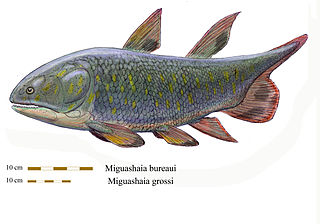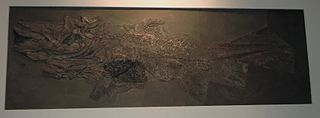| Holopterygius | |
|---|---|
| Scientific classification | |
| Kingdom: | |
| Phylum: | |
| Class: | |
| Family: | |
| Genus: | Holopterygius |
Holopterygius is an extinct genus of prehistoric eel-like coelacanth. Despite its specialized morphology and superficial dissimilarity to the usual coelacanth body plan, it is one of the most basal actinistian fish. [1]

Strunius is an extinct genus of lobe-finned fish from the Late Devonian period of Germany.
The Byblos Fossil Museum is a museum in Byblos, Lebanon. This museum contains fossil collections of sharks, eels, shrimps, squids, rays, coelacanthes and flying fish. It was opened in 1991 and is in the old souk of Byblos. Most of its collection comes from the nearby villages of Haqel-Byblos, Hjula, and Ennammoura.

Styloichthys is a prehistoric sarcopterygian, lobe-finned fish which lived during the Early Devonian (Lochkovian) period of East Yunnan, South China.

Miguashaia is a genus of prehistoric lobe-finned fish which lived during the Devonian period. Miguashaia is the most primitive coelacanth fish.

Miguashaiidae is an extinct family of prehistoric coelacanth fishes which lived during the Devonian period.

Sinocoelacanthus is an extinct genus of prehistoric coelacanth that lived during the Early Triassic epoch.
Euporosteus is an extinct genus of prehistoric sarcopterygian or lobe-finned fish.
Lochmocercus is an extinct genus of prehistoric coelacanth fishes which lived during the Carboniferous Period.
Indocoelacanthus robustus is a fossil sarcopterygian. The holotype specimen was found in Lower Jurassic-aged riverine sediment of the Kota formation, in the Pranhita-Godavari valley at Boraigudem limestone ridge, about 30 kilometers southeast of Sironcha, India. The holotype is preserved in the museum of the Indian Statistical Institute.
Holodipterus is an extinct genus of prehistoric sarcopterygian or lobe-finned fish.

Heptanema is an extinct genus of prehistoric coelacanth from the Middle Triassic (Ladinian) of northern Italy.
Hainbergia is an extinct genus of prehistoric sarcopterygian or lobe-finned fish.

Mylacanthus is an extinct genus of prehistoric sarcopterygians or lobe-finned fish.
Moenkopia is an extinct genus of prehistoric sarcopterygians from the Coelacanthidae found in the Middle Triassic Moenkopi Formation of Arizona. The type, and only species, M. wellesi, was named in 1961 in honour of Samuel Paul Welles. It is only known from the holotype, UMCP 36193, a partial skull consisting only of the basisphenoid that was collected in 1939 or 1940 by Samuel Welles and briefly noted on by him in 1947, and other assorted specimens found before 2005 in the Radar Mesa by S. J. Nesbitt, W. G. Parker and R. B. Irmis.
Sassenia is an extinct genus of prehistoric coelacanth.
Youngichthys is an extinct genus of prehistoric sarcopterygians or lobe-finned fish from the Upper Permian comprising a single species, Youngichthys xinghuansis. The single specimen of the fish was discovered in Zhejiang Province, China in 1981.
Swenzia is an extinct genus of coelacanthid fish from the late Jurassic of France. It contains a single species, S. latimerae, which was originally described as Wenzia latimerae. Because the generic name Wenzia was already preoccupied by a snail, the generic name was amended to Swenzia. It is the fossil genus most closely related to the living coelacanth, Latimeria.

Trachymetopon is an extinct genus of prehistoric coelacanth from the Early Jurassic Posidonia Shale of Germany and the Middle Jurassic of France. Only one species has been named, Trachymetopon liassicum, described by Henning in 1951 from an almost complete specimen found in the Lower Toarcian of Ohmden in Baden-Württemberg. Another specimen is known from the same site, and two older specimens come from the Sinemurian of Holzmaden. The holotype of this species is 1.6 metres in length. A giant specimen of an undetermined species of Trachymetopon is known from the Middle Jurassic of Normandy. This specimen, composed of a 53 cm long palatoquadrate, belongs to an individual 4 metres (13 ft) in length. A study published in 2015 revealed that this coelacanth belongs to the Mawsoniidae. Trachymetopon is one of the few known mawsoniids to have been exclusively marine, while most of the other members of the group have lived in fresh and brackish waters.
Spermatodus is an extinct genus of prehistoric coelacanth, or lobe-finned fish.
Athrodon is a genus of extinct pycnodontid that lived in shallow seas in what is now England and France from the Late Jurassic until the genus extinction during the start of the late Cretaceous. The various species are very similar in splenial bone and tooth morphology to Mesodon. Otherwise, no articulated or complete specimen is known: all fossils specimens are bone fragments and disarticulated teeth.